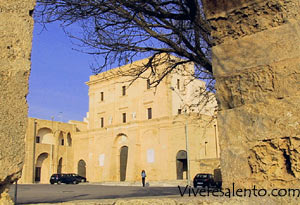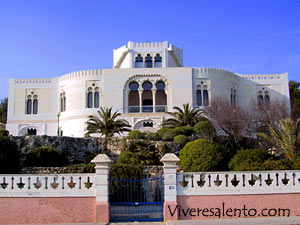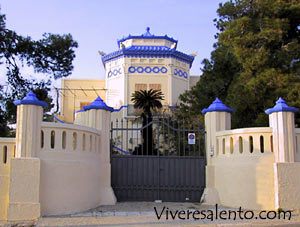|
|

The Sanctuary of the Madonna of Leuca,
destination of many devotees, was made built by Pope Giulio I, in 343
, on the rests of a pagan temple dedicated to the Goddess Minerva. According to
a legend when St. Peter arrived at Leuca from the East, he put the Cross on the
ground and the temple, mysteriously, crumbled. The first pilgrims visited it
already in the Middle Ages and, later, even some kings and dukes addressed to
the Madonna for help. During the Turkish invasion, Boemondo Of Altavilla, having
been captured, implored the help of the Madonna. When he was released he went on
pilgrimage with his faithful knights to the sanctuary . Also the crusaders went
to the sanctuary to pray before leaving for the war, and the same happened for
the soldiers during the second world war. The Sanctuary is famous in all the
Salento, and each year in the spring months, many believers arrive on pilgrimage
from the neighbouring villages. This holy place was destroyed and reconstructed
a lot of times. The most well known assault happened in 1624, when the pirates
set the church on fire. Everything was destroyed, except for a
fragment of the painting of Jacopo Palma, representing the faces of the Madonna
and of the Child. From that fragment, Andrea Cunavi repainted the canvas that,
currently, can be seen in the Sanctuary. In 1689, the Algerians invaded the
coast again, they emptied the church and stole even the bells and, before going
away, they destroyed the column of the Madonna that was in front of the Church.
In 1694 a rich woman, Laura Guarini, made the column build again. In 1718 the
Sanctuary was rebuilt for want of the Bishop Giovanni Giannelli, who decided to
strengthen it adding the towers. Theworks ended in 1740, three years before the
death of the bishop. The only difference between the actual construction and the
one wanted by the Bishop
to the Goddess Minerva. According to
a legend when St. Peter arrived at Leuca from the East, he put the Cross on the
ground and the temple, mysteriously, crumbled. The first pilgrims visited it
already in the Middle Ages and, later, even some kings and dukes addressed to
the Madonna for help. During the Turkish invasion, Boemondo Of Altavilla, having
been captured, implored the help of the Madonna. When he was released he went on
pilgrimage with his faithful knights to the sanctuary . Also the crusaders went
to the sanctuary to pray before leaving for the war, and the same happened for
the soldiers during the second world war. The Sanctuary is famous in all the
Salento, and each year in the spring months, many believers arrive on pilgrimage
from the neighbouring villages. This holy place was destroyed and reconstructed
a lot of times. The most well known assault happened in 1624, when the pirates
set the church on fire. Everything was destroyed, except for a
fragment of the painting of Jacopo Palma, representing the faces of the Madonna
and of the Child. From that fragment, Andrea Cunavi repainted the canvas that,
currently, can be seen in the Sanctuary. In 1689, the Algerians invaded the
coast again, they emptied the church and stole even the bells and, before going
away, they destroyed the column of the Madonna that was in front of the Church.
In 1694 a rich woman, Laura Guarini, made the column build again. In 1718 the
Sanctuary was rebuilt for want of the Bishop Giovanni Giannelli, who decided to
strengthen it adding the towers. Theworks ended in 1740, three years before the
death of the bishop. The only difference between the actual construction and the
one wanted by the Bishop
 Giannelli, is the absence of the towers and of the drawbridges. The church has an only aisle, seven altars, including the high
altar, on which you can see the miraculous canvas of the Lady with the Child,
and other religious decorations that were given by the Marquis Virginio Bourbon
in 1835. The Sanctuary was declared "Minor Basilica" in 1990 by Pope Giovanni
Paolo II. The Parish of Santa Maria di Leuca is dedicated to Jesus Christ , and
it has been run by the Franciscan Monks from 1943. It was built at the end of
the XIX century, and the façade and the three portals are in neo-Gothic style .
The famous Lighthouse of Leuca is very interesting too: it was built where once
there was the tower that Filippo II made build in 1527. It was inaugurated in
1866, it is 45 meters tall and it emanate, regularly, bundles of light that
signal the coast for 50 Km of distance. An other fascinating characteristic of
Leuca is the presence of marvelous villas. Until the XIX century there were only
the modest residences of the fishermen. Later imposing villas were built and
they contributed to make Leuca become a tourist destination of first level.
Quite in front of the harbour you can admire the stately Daniele Villa, built in
e 1880 and planned by the engineer Achille Rossi, Giannelli, is the absence of the towers and of the drawbridges. The church has an only aisle, seven altars, including the high
altar, on which you can see the miraculous canvas of the Lady with the Child,
and other religious decorations that were given by the Marquis Virginio Bourbon
in 1835. The Sanctuary was declared "Minor Basilica" in 1990 by Pope Giovanni
Paolo II. The Parish of Santa Maria di Leuca is dedicated to Jesus Christ , and
it has been run by the Franciscan Monks from 1943. It was built at the end of
the XIX century, and the façade and the three portals are in neo-Gothic style .
The famous Lighthouse of Leuca is very interesting too: it was built where once
there was the tower that Filippo II made build in 1527. It was inaugurated in
1866, it is 45 meters tall and it emanate, regularly, bundles of light that
signal the coast for 50 Km of distance. An other fascinating characteristic of
Leuca is the presence of marvelous villas. Until the XIX century there were only
the modest residences of the fishermen. Later imposing villas were built and
they contributed to make Leuca become a tourist destination of first level.
Quite in front of the harbour you can admire the stately Daniele Villa, built in
e 1880 and planned by the engineer Achille Rossi, who also planned Episcopo Villa, very well-known since it looks like a Chinese
pagoda. Another interesting villa is Ruggeri Villa, also called Meridian Villa,
planned in 1874 by Giuseppe Ruggeri: what most marks this building is the
meridian on the principal façade. Ruggeri also projected Sangiovanni Villa in
Egyptian style and Mellacqua villa, in neo-Gothic style . At Leuca there are
around 50 villas: Pia Villa, Villa dei Misteri, Comi Villa etc.The principal aim
was to arouse admiration and envy towards the wealthy people that wanted to have
the most beautiful and original villa. Along the coast of Leuca you can see
numerous caves , the most important is the Porcinara. It is marked by three very
deep rooms that can be reached thanks two entries. On the walls there are some
Latin and Greek
who also planned Episcopo Villa, very well-known since it looks like a Chinese
pagoda. Another interesting villa is Ruggeri Villa, also called Meridian Villa,
planned in 1874 by Giuseppe Ruggeri: what most marks this building is the
meridian on the principal façade. Ruggeri also projected Sangiovanni Villa in
Egyptian style and Mellacqua villa, in neo-Gothic style . At Leuca there are
around 50 villas: Pia Villa, Villa dei Misteri, Comi Villa etc.The principal aim
was to arouse admiration and envy towards the wealthy people that wanted to have
the most beautiful and original villa. Along the coast of Leuca you can see
numerous caves , the most important is the Porcinara. It is marked by three very
deep rooms that can be reached thanks two entries. On the walls there are some
Latin and Greek
 inscriptions
dating back to the II century A.C. In the past, in this cave, probably, pagan
and Christian rites were celebrated. Now the cave is closed in order to avoid
vandal attacks. The other most important caves are: Cave del Pozzo, Cave Le
Mannute, Cave of the Devil, Cazzafri Cave and so many others that the tourists,
in the summer months, visit with much interest. inscriptions
dating back to the II century A.C. In the past, in this cave, probably, pagan
and Christian rites were celebrated. Now the cave is closed in order to avoid
vandal attacks. The other most important caves are: Cave del Pozzo, Cave Le
Mannute, Cave of the Devil, Cazzafri Cave and so many others that the tourists,
in the summer months, visit with much interest.
|